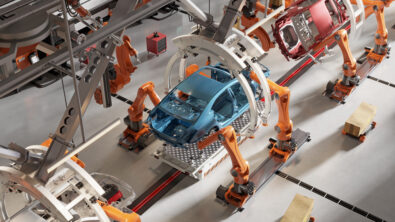Automotive IC design: it’s not a computer science project (it’s art)
“Not a computer science project.” That’s how an automotive IC design manager I worked with once fabulously described what IC design should not be during a product definition meeting. I liked his viewpoint. What he meant was: This is a business, not an academic exercise or homework assignment. There are competitors, customers, and opportunity for success and failure. Designing silicon for automotive applications is a multi-million dollar investment, that like any investment must be supported by ROI analysis and comes with opportunity cost.
The required technical and financial analysis is confounded by the fact that we are designing for a market (automobiles) that typically has five- to seven-year design cycles, while ICs have a Moore’s-Law-enshrined 18-month to two-year design cycle, from concept to production. How do you map the two flows together while minimizing risk, maximizing creativity, providing value and differentiation to car OEMs and tier 1s — all whilst keeping within power and cost budgets, and getting the thing to market ahead of your competitors?
Well, there are a few approaches. Let’s look at the automotive microcontroller market, which is worth around $7B annually, according to Strategy Analytics. Microcontrollers are typically processors with non-volatile memory, usually embedded flash from around 4KB up to 16MB or more. Typically there are around 100 of these sprinkled around the vehicle inside a network of ECUs. They are highly configurable, network-connected (often via the CAN bus) and control, among other things, many of the highly distributed car body electronics and comfort features within the vehicle, such as door locks, sunroof, motor control and lighting. There are three or four big suppliers in the automotive MCU market, each with highly specialized automotive design capability, and the market is competitive. Market share is generally won through adding value at the system level, a task made all the more difficult by requirements like ISO 26262 compliance and lock-step design and redundancy everywhere. But the major auto IC design companies know how to hit all these check boxes. How do you beat the competition then?
One way that doesn’t work, or at least shouldn’t be the centerpiece of your strategy, is competing on price. Driving the market to commoditization benefits no one in the supply chain and is the anti-innovation approach. You may win a few points of market share short term but research shows that market share gain in semiconductors has a positive correlation to average selling price. So long term market share gain is driven by value creation.
The better if more challenging way to go is to differentiate on functionality. But this is where the “computer science project” risk comes in. Designing what the marketing team thinks is cool or what the design team thinks is clever doesn’t necessarily translate into something the end customer will pay for. A few questions need to be asked before you get started:
- What makes sense to implement in silicon hardware vs software? What features solve problems for customers with their ECU design, ideally lowering overall system cost while adding performance and functionality? Having a menu of ‘new features’ makes for a great powerpoint presentation but doesn’t necessarily mean maximum value for customers if your expensive on-chip peripherals are solving problems that could more cost effectively be addressed in software. What about configurable peripherals, that can be programmed to perform different complex tasks in software, allowing for overall chip size reduction whilst simultaneously providing maximum flexibility and functionality? This is a better and increasingly popular approach. The overused ‘scalability’ term really does apply in this market, with ECU designers wanting to swap out one MCU for another with the same packaging footprint (to reuse the same PCB layout) but perhaps with more memory and a different configuration of communications peripherals. Smart peripherals are appealing.
- How can you add value by reducing your customers’ development time? If you can provide a complete development environment along with the MCU that makes it easy to prototype, provide software code examples for specific functions such as complex window lift algorithms, and an intuitive user interface that allows new engineers to add value through software quickly, then the customer’s hardware design manager will likely want to talk to you. And if you can provide all that within an Autosar environment, even better. The army of young talented automotive EE engineers coming into the industry in China, for example, needs to get familiar with MCU architectures fast. Providing a complete hardware and software development environment is of high value to tier 1s and carmakers as they rush to get new electronics-enabled features into their cars before the competition does.
- Where to begin with all the design trade-offs to build in value to your IC design? This is the area of design exploration: quickly evaluate different options, define priorities, trade off die size against performance, trade that against power consumption, iterate and refine using other combinations of on-chip IP against what can be implemented in software. The product manager that has freedom to evaluate these different permutations of IP, and has solid data to make these trade off decisions, is better placed to get the right product to market first. And this means working closely with the IC design team, in a design environment where the designers have the right tools to provide fast analysis of different design scenarios. If the software tools or project timeline only allows for one or two iterations, the final product will likely not be optimized. Better to work in parallel — start on the MCU development user interface, and start developing and testing all the software needed, with a solid pre-silicon emulation strategy. When the first silicon eventually drops out of the wafer fab, having hardware tools and a full software suite ready to go adds more value.
You need deep market insight to even start to answer these questions. “Understand the customer problem,” any marketing consultant will tell you. Of course the consultant is right, at least to a point. But competitive advantage is usually rooted in subtlety, and value-creation comes from trial and error. Try 10 things, 3 of them work, and one of those gives a real insight and sets a new direction for the product development strategy. IC designers need freedom to try crazy ideas, but they are more time pressed than most in the organization. So finding ways to let them drift off the standard process path and explore their own gut feel of ‘this might just work’ idea is where real value is created. In the real world, however, this requires increased productivity so that the (over) aggressive schedule can still be hit. This means having the right silicon design tools that facilitate this design exploration process — increasing productivity and simultaneously freeing the inner artist inside the IC designer to go invent, create and dazzle. And after this optimized and unique IC is defined, you need the right emulation products to optimize the software (both runtime and software tools), and eventually get to market first with a complete MCU design solution.
In the next blog, we will look at the back end of the process, including how to manage cost in the manufacturing area and more on how design automation tools can give a market advantage.
For further reading, see the whitepaper “Being a Player in the Automotive IC Market.”


